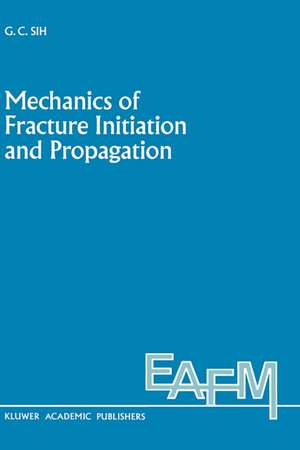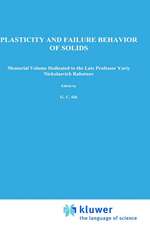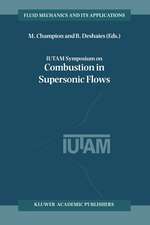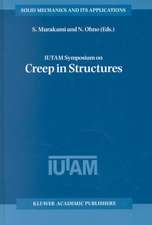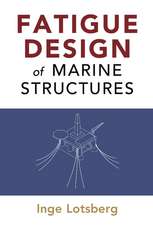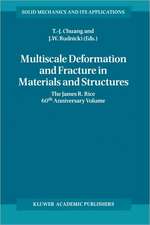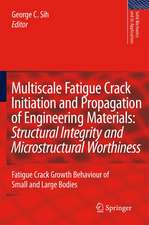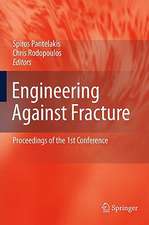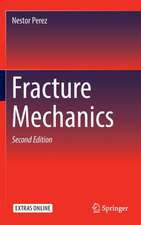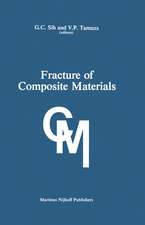Mechanics of Fracture Initiation and Propagation: Surface and volume energy density applied as failure criterion: Engineering Applications of Fracture Mechanics, cartea 11
Autor George C. Sihen Limba Engleză Hardback – 30 apr 1991
| Toate formatele și edițiile | Preț | Express |
|---|---|---|
| Paperback (1) | 951.14 lei 6-8 săpt. | |
| SPRINGER NETHERLANDS – 24 sep 2012 | 951.14 lei 6-8 săpt. | |
| Hardback (1) | 957.32 lei 6-8 săpt. | |
| SPRINGER NETHERLANDS – 30 apr 1991 | 957.32 lei 6-8 săpt. |
Preț: 957.32 lei
Preț vechi: 1167.45 lei
-18% Nou
Puncte Express: 1436
Preț estimativ în valută:
183.20€ • 190.18$ • 152.76£
183.20€ • 190.18$ • 152.76£
Carte tipărită la comandă
Livrare economică 22 martie-05 aprilie
Preluare comenzi: 021 569.72.76
Specificații
ISBN-13: 9780792308775
ISBN-10: 0792308778
Pagini: 410
Ilustrații: XXII, 410 p.
Dimensiuni: 155 x 235 x 24 mm
Greutate: 0.79 kg
Ediția:1991
Editura: SPRINGER NETHERLANDS
Colecția Springer
Seria Engineering Applications of Fracture Mechanics
Locul publicării:Dordrecht, Netherlands
ISBN-10: 0792308778
Pagini: 410
Ilustrații: XXII, 410 p.
Dimensiuni: 155 x 235 x 24 mm
Greutate: 0.79 kg
Ediția:1991
Editura: SPRINGER NETHERLANDS
Colecția Springer
Seria Engineering Applications of Fracture Mechanics
Locul publicării:Dordrecht, Netherlands
Public țintă
ResearchCuprins
1. A special theory of crack propagation.- 1.1 Historical remarks.- 1.2 The strain energy density concept.- 1.3 Fundamental hypotheses on crack initiation and direction.- 1.4 Prediction of crack growth direction.- 1.5 Intrinsic property of strain energy density factor.- 1.6 Mixed mode fracture criterion.- 1.7 Concluding remarks.- 1.8 References.- 2. A three-dimensional strain energy density factor theory of crack propagation.- 2.1 Preliminary remarks.- 2.2 Generalized stress field near crack border.- 2.3 Strain energy density factor.- 2.4 Basic assumptions of the theory.- 2.5 Minimum values of S.- 2.6 Application of the S-theory to the elliptical crack problem.- 2.7 Shape of fracture increment.- 2.8 Concluding remarks.- 2.9 Appendix 2.1: Elliptical crack in tension.- 2.10 Appendix 2.2: Combined Mode I and III loading.- 2.11 Appendix 2.3: Elliptical crack in compression.- 2.12 References.- 3. Straiu energy density theory applied to plate-bending and shell problems.- 3.1 Introductory remarks.- 3.2 Strain energy density factor theory.- 3.3 Bending and twisting of cracked plates.- 3.4 Direction of crack growth.- 3.5 Minimum strain energy density factors and allowable bending moments.- 3.6 Additional results on plates.- 3.7 Shell theory with shear deformation.- 3.8 Symmetric loading on shell.- 3.9 References.- 4. Dynamic crack problems — strain energy density fracture theory.- 4.1 Preliminary remarks.- 4.2 Strain energy density criterion in elastodynamics.- 4.3 Mixed mode impact.- 4.4 Standing plane waves impinging on a crack.- 4.5 Crack bifurcation.- 4.6 Summary and conclusions.- 4.7 References.- 5. Strain energy density and surface layer energy for blunt cracks or notches.- 5.1 Background information.- 5.2 Surface layer energy.- 5.3 Strain energy density theory.- 5.4 Theembedded elliptical notch.- 5.5 Two external notches.- 5.6 Concluding remarks.- 5.7 References.- 6. Thermoelastic and hygrothermoelastic behavior of cracks.- 6.1 Introduction.- 6.2 Linear thermoelasticity.- 6.3 Fracture caused by nonuniform temperature changes.- 6.4 Simultaneous application of thermal and mechanical loading.- 6.5 Thermally induced slow crack growth.- 6.6 Hygrothermoelasticity.- 6.7 Effect of heat/moisture/load on crack behavior.- 6.8 Failure enhanced by temperature and moisture changes.- 6.9 References.- 7. Failure of composites as predicted by the strain energy density theory.- 7.1 Preliminary remarks.- 7.2 Srain energy density criterion.- 7.3 Failure of fiber, matrix or interface.- 7.4 Unidirectional fiber/matrix composite.- 7.5 Comparison of results obtained from anisotropic and matrix cracking model.- 7.6 Angle-ply laminates.- 7.7 Impact and cracking of unidirectional composites.- 7.8 Concluding remarks.- 7.9 Appendix 7.1: Calculation of gross mechanical properties of unidirectional composites.- 7.10 Appendix 7.2: E-glass-epoxy resin composites.- 7.11 Appendix 7.3: Stainless steel-aluminum composite.- 7.12 References.- 8. Experimental fracture mechanics: strain energy density criterion.- 8.1 Preliminary remarks.- 8.2 Mechanical properties of materials.- 8.3 Fracture mechanics discipline.- 8.4 Incremental crack growth.- 8.5 Fatigue crack growth: a path-dependent process.- 8.6 Concluding remarks.- 8.7 References.- 9. Isoenergy density theory: exchange of surface and volume energy.- 9.1 Introduction.- 9.2 Surface energy: micro- and macrocrack models.- 9.3 Volume energy: local and global instability.- 9.4 Damage resistance concept: scaling in size and time.- 9.5 Interaction between surface and volume energy: nonhomogeneous energy dissipation.- 9.6 References.- Author index.
